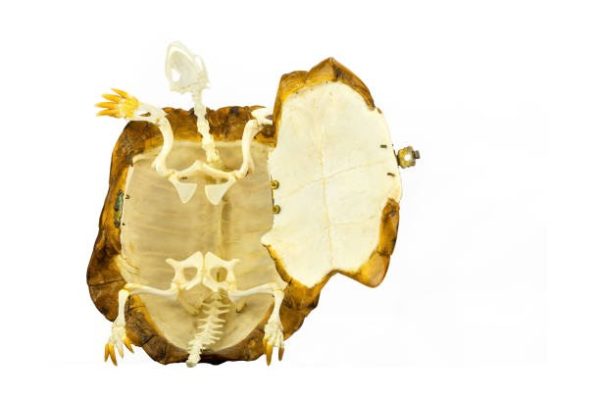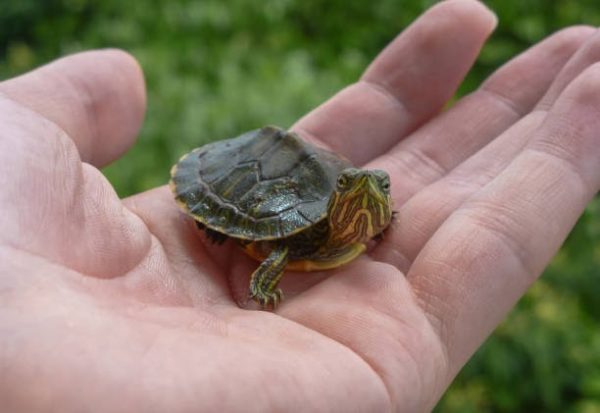It’s natural for humans to come to an incorrect conclusion about the anatomy of turtles. But believing that turtles and tortoises can live without their hard shells is not true. Honestly speaking, turtles cannot survive for even a second without their shell.
That’s because a tortoise’s shell not only acts as a cage but it also includes nerve endings and bones. Since the shell has nerve endings, turtles can feel it when someone touches the shell. In fact, a turtle feels pain when the shell gets damaged.
If you want to know further about turtles and why they cannot live without a shell, keep reading!
Table of Contents
Why Do Turtles Have Shells?

A turtle’s and tortoise’s shell is more than just a home to them. This hard structure was first seen during the era of dinosaurs, where the shell serves a specific role.
Lately, turtles and tortoises were also seen with a similar hard structure called the shell. But why do these creatures have shells? Is it just for protection, or does the shell serve some other purpose as well?
Before we get into details, let’s see what the turtle shell is made of. Well, it’s made of around 60 fused bones and a part of the turtle’s spine. The shell is constructed using two pieces, i.e., plastron (bottom) and carapace (top).
Besides these materials, the shell also has rough scales called scutes. The scale offers protection against scratches and bruises.
Now, let’s answer why turtles have shells? As you have seen, turtle shells are the toughest part, and they can protect them from nearly any kind of chewing or scratching of predators.
If you plan to keep a turtle as a pet, you must know the right way of taking care of the turtle and tortoise.
Why Can’t Turtles Live Without a Shell?

A tortoise’s shell is something that sets it apart from other aquatic animals. Whether sea turtles or land turtles, their shell makes them easily recognized. But the question is, why can’t turtles live without their hard shells?
That’s because the turtle’s shell is a part of the skeleton that cannot be removed. Sadly, land turtles or pet turtles would die a painful death without their tough shell. It’s even horrible to think about doing such a thing.
Before moving further and seeing why turtles can’t live without their shell, let’s see what their shells are made of.
The Carapace
The upper part of the shell is made of a substance called carapace. This part is in the shape of a dome and is made of flattened ribs along with parts of the backbone.
The Plastron
After the upper part comes the lower part. This part of the tortoise’s shell is made of plastron. It’s usually flat, but for some turtle species, it’s curved. One interesting thing about this part is that it’s made of nine bones.
The Bridge
The bridge in the turtle’s shell is the part that connects the carapace and plastron, i.e., the lower and the upper shells. It’s found on both sides, and the origin of this special bonding material is unknown.
The bridge in every tortoise’s shell has two roles. The first is to keep the turtle protected. And the second is to fuse the lower and upper shell parts.
The Scutes
At last, comes the main part of a turtle’s shell. It’s called scutes. It is made of keratin, and it offers a layer of protection to the carapace.
The scutes protect the upper part of the tortoise’s shell even from the sharp jaws. Therefore, when animals or reptiles with sharp teeth try to bite a turtle or tortoise, the carapace is not damaged because the scutes take all the wear and tear.
The best thing is that aquatic turtles and tortoises shed scutes and grow new ones quickly. Also, certain turtles like leatherback turtles don’t have hard scutes, but they have a similar material that protects the upper part of their shells.
Now, let’s understand why land and sea turtles cannot live without their thicker shells.
Shell Is Sea Turtles Skeletal System
As we have mentioned a couple of times, a tortoise’s shell is not just its home but also its skeletal system. That’s because the shell has nerve endings and bones. Turtles without shells would look like melted jello.
While shells are important to turtles and tortoises, a few things can even damage them. Things like vitamin D deficiency, calcium deficiency, and poor diet can risk the hardest shells. In addition, if the shell gets damaged, the internal organs come at a risk.
Turtle’s Shell Act As Their Self-Defense
Now comes the most well-known purpose of the shell, i.e., protection. A tortoise’s shell is made of substances that cannot be broken easily. Therefore, it can withstand reptiles’ powerful jaws or any other animal attack.
So, whether it’s the brutal force of alligators, birds, or whales, the tortoise’s shell remains unharmed.
Turtle Shells Protect Them From The Sun
Another known purpose of the shell is protecting the tortoise and turtle from UV light. Without a shell, the tortoise’s internal organs would dehydrate to a point where this reptile would die.
When the turtle’s shell absorbs harsh UV rays, it synthesizes vitamin D. This way, the body of the land and sea turtle stays in good shape.
If you are still curious to know how turtles and tortoises would look without a shell, you can search for Odontochelys semitestacea. It was the closest ancestor of turtles that had half-shells.
What Happens If A Turtle Loses Its Shell?
A turtle’s shell is an important part of its body. No matter what you do, you cannot make a tortoise or turtle live without its shell. Not only can you not make a tortoise leave the shell, but also it cannot lose the shell. It’s just not possible.
But there is one thing that can happen. Under certain circumstances, turtles can end up having a broken or cracked shell. Depending on the severity of the injury, a vet can fix it.
Most turtles cannot survive massive shell damage. So, you should never try to break a turtle’s shell because it would decrease or take away the turtle’s life. Image source- unsplash.com
Can Tortoises And Turtles Survive A Broken Shell?

While a tortoise cannot live without its hardest shell, it can surely survive a cracked shell. Yes, you have read that right! Surely, shell damage is dangerous, but it’s not like an immediate death sentence. And you do know what? You can even do a couple of things to save the tortoise.
Let’s see why a broken shell won’t take away a tortoise’s life. A crack in the shell means a slight opening up of the turtle’s body. You can think of it as a crack in your fingernail- it’s painful, but it won’t kill you.
If the injury is left unattended, it can become dangerous. Unfortunately, a crack in the shell does not always show that there has been an attack. Sometimes, it’s a result of a bad diet and an unsanitary tank.
In such a case, the tortoise can also develop shell ulcers. This deadly process is called shell rot. In this case, it’s better to take your turtle to a vet immediately and look for possible issues like metabolic bone disease, liver disease, kidney damage, and thyroid issues.
How To Fix Broken Turtle Shell At Home

In case if the hardest shell of your tortoise has been damaged and you cannot immediately take it to the vet, you can do a few things to decrease its pain.
- You can start by cleaning the wound. For this, you can use cleaners like diluted Iodine or chlorohexidine solution. You can apply any of the solutions a couple of times. This way, the wound would stay clear from debris and dirt.
- Whether you are fixing a sea turtle’s shell or a land turtle’s shell, you need to keep the cracked area clean because it can become an easy target for bacteria.
- Softshell turtles can simply slip or can meet from a massive accident, which can result in shell damage. So, depending on the severity of the injury, you can give your turtle antibiotics.
- If your tortoise has any large cracks, you need to get it fixed by visiting immediately to a vet. There are a few other ways to fix a broken shell, but you should not take any kind of risk by experimenting with your pet’s health.
- If needed, you can apply a fiberglass patch to your turtle’s body. The fiberglass material can easily cover up the area. However, to apply fiberglass appropriately, you might need to apply a few coats of glue.
- After a couple of days of applying fiberglass, you can apply resin. This way, you can keep the water from getting inside the turtle’s body. After applying resin, you should wait for some time so that it can dry completely. If you don’t wait, the resin might not protect your turtle.
- Once turtle and tortoise shells are dried completely, you can put the turtle back into its enclosure.
While minor shell injuries can be fixed at home, you should consult a vet if the damage is serious. The reason? Because a broken shell becomes an easy target to bacteria and it can quickly get affected.
If the shell damage is left unattended for a long time, it can lead to extensive internal organ damage that we cannot see. If the situation gets worse, the vet might need to rebuild the shell fully.
The turtle shells heal and the process can take up to a year. Also, by evaluating the shell damage, the vet can help you understand how to take care of it.
One thing that needs to be remembered is that a turtle with a broken shell is not compatible for living with a fish. That’s because the bacteria attacking the broken shell can harm fish as well. So, if you wish to make turtles and fish live together, make sure that turtles are healthy.
Does A Tortoise Shell Heal By Itself?
Tough shells help turtles and tortoises to escape even strong jaws, but the attack can take a toll on their shells. So whether it’s alligators, sharks, whales, birds, or any other predator, they try to crack open up a turtle carapace with just a few bites.
In certain unfortunate situations, tortoises get killed, and predators then feed on the soft tissue covered by shells. So, the brute force applied by predators turns out to be life-taking.
Now, the question is- can a turtle shell repair itself after damage? The answer to this question is yes! How you might wonder? That’s because turtle shells are made of organic and natural materials. The shell acts like a rib cage and protects the limbs inside and other organs.
These materials are known to heal themselves. That means your turtle can stay alive. But it’s not recommended to wait for the turtle shells to heal by itself. That’s because even the slightest crack can make your pet exposed to dangerous bacteria.
How Strong Is A Turtle Shell?

If you want to know how strong a turtle shell is, you should probably find the answer to how much force to apply to open a turtle shell. Since modern turtle’s shells are extremely hard, you should put pressure worth a thousand pounds.
The turtle shell has an average toughness of around 36.4MPa m1/2. That means just a few bites of predators’ jaws might not damage the hard shell.
In general, the biggest threat to tortoises is big cats like jaguars and other species like sharks, alligators, birds, and whales.
Can Tortoises And Turtles Get Out Of Their Shell?
Another commonly asked question is can tortoises get out of their shell? Well, they cannot, and neither should you make them get out of it because a turtle shell is a part of its exoskeleton.
Since shells are a part of tortoises’ bodies, there is no safe and quick way of removing them. Doing so can cause tortoises great pain, and sometimes, it can even kill them.
Shell for tortoises is like skin for humans. Just as peeling skin is painful, similarly removing a turtle from its shell is not pleasing.
Another interesting thing to notice is that tortoises and turtles never outgrow their shells. That’s because the turtle grows its shell with it. Just as vertebrae grow with humans, the shell grows with tortoises.
Are Turtles Born With Shells?

Commonly people think that tortoises are not born with shells, but that’s not true. Tortoises and turtles are born with shells. Initially, they have softer shells, but as they mature, they get hard shells that protect them from potential predators like sharks, birds, alligators, and other animals.
Also, tortoises never shed their shells as other species do. Throughout its life, a turtle will have its shell as the ribs and organs of its body are covered via a shell.
Another thing that you must note is that no turtle can change its shell. That’s because they don’t shed.
Frequently Asked Question
Tortoise shells are not bulletproof. That’s because their shell is made of 60 different bones. Also, the shell has nerves that supply blood. So, if there is an injury or if something breaks the shell, tortoises would feel pain.
Just like other aquatic animals and species, turtles also sleep inside the water. They sleep for around an hour before coming out to get fresh air.
If the turtle shell is safe and it has clear eyes, that means it’s healthy. Also, a healthy turtle does not show any signs of breathing difficulty. So it would be fit and healthy in all aspects.
If your turtle is dead, it will show some potential signs like bad odor, its shell would be rotten, sunken eyes, and it would show no response to stimulation.
A turtle needs enough calcium to maintain a healthy shell. Besides calcium, a turtle also needs vitamins and minerals so that its shell can grow at the same pace as its body.
Conclusion
A shell is a part of a turtle’s body that protects it from the jaws of dangerous animals and predators. A turtle shell is made of bones, ribs, and other bony plates that are difficult to break. If you want to break a turtle’s shell, you would have to apply pressure worth a thousand pounds.
Removing the hard shells would make the turtle die a painful death. That’s because turtles without shells would look like melted jello. Also, turtles without shells can become an easy target to bacteria attack.
Turtles need their shell for a variety of reasons, like keeping themselves safe from predators, digging the mud, escaping the heat, and most importantly, surviving. Therefore, removing a turtle’s shell is not a pleasing experience for them. It can even cause them immense pain to the point where they might die an unfortunate death.
Also, in case of a damaged shell, make sure that your turtle gets immediate medical help.
